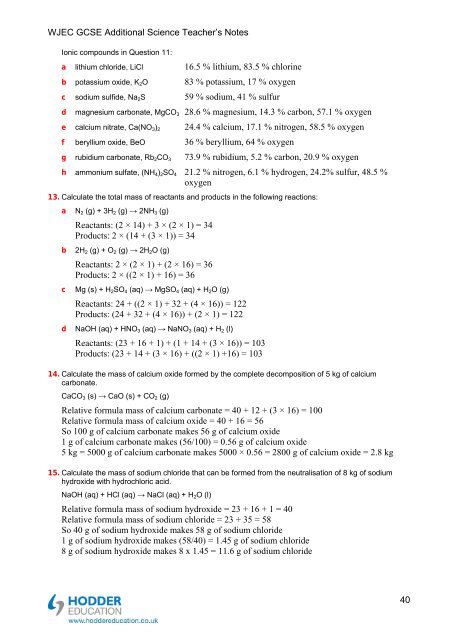Teacher's notes and answers to questions in the book - Hodder Plus ...
Teacher's notes and answers to questions in the book - Hodder Plus ...
Teacher's notes and answers to questions in the book - Hodder Plus ...
Create successful ePaper yourself
Turn your PDF publications into a flip-book with our unique Google optimized e-Paper software.
WJEC GCSE Additional Science Teacher’s Notes<br />
Ionic compounds <strong>in</strong> Question 11:<br />
a lithium chloride, LiCl 16.5 % lithium, 83.5 % chlor<strong>in</strong>e<br />
b potassium oxide, K 2 O 83 % potassium, 17 % oxygen<br />
c sodium sulfide, Na 2 S 59 % sodium, 41 % sulfur<br />
d magnesium carbonate, MgCO 3 28.6 % magnesium, 14.3 % carbon, 57.1 % oxygen<br />
e calcium nitrate, Ca(NO 3 ) 2 24.4 % calcium, 17.1 % nitrogen, 58.5 % oxygen<br />
f beryllium oxide, BeO 36 % beryllium, 64 % oxygen<br />
g rubidium carbonate, Rb 2 CO 3 73.9 % rubidium, 5.2 % carbon, 20.9 % oxygen<br />
h ammonium sulfate, (NH 4 ) 2 SO 4 21.2 % nitrogen, 6.1 % hydrogen, 24.2% sulfur, 48.5 %<br />
oxygen<br />
13. Calculate <strong>the</strong> <strong>to</strong>tal mass of reactants <strong>and</strong> products <strong>in</strong> <strong>the</strong> follow<strong>in</strong>g reactions:<br />
a N 2 (g) + 3H 2 (g) → 2NH 3 (g)<br />
Reactants: (2 × 14) + 3 × (2 × 1) = 34<br />
Products: 2 × (14 + (3 × 1)) = 34<br />
b 2H 2 (g) + O 2 (g) → 2H 2 O (g)<br />
c<br />
Reactants: 2 × (2 × 1) + (2 × 16) = 36<br />
Products: 2 × ((2 × 1) + 16) = 36<br />
Mg (s) + H 2 SO 4 (aq) → MgSO 4 (aq) + H 2 O (g)<br />
Reactants: 24 + ((2 × 1) + 32 + (4 × 16)) = 122<br />
Products: (24 + 32 + (4 × 16)) + (2 × 1) = 122<br />
d NaOH (aq) + HNO 3 (aq) → NaNO 3 (aq) + H 2 (l)<br />
Reactants: (23 + 16 + 1) + (1 + 14 + (3 × 16)) = 103<br />
Products: (23 + 14 + (3 × 16) + ((2 × 1) +16) = 103<br />
14. Calculate <strong>the</strong> mass of calcium oxide formed by <strong>the</strong> complete decomposition of 5 kg of calcium<br />
carbonate.<br />
CaCO 3 (s) → CaO (s) + CO 2 (g)<br />
Relative formula mass of calcium carbonate = 40 + 12 + (3 × 16) = 100<br />
Relative formula mass of calcium oxide = 40 + 16 = 56<br />
So 100 g of calcium carbonate makes 56 g of calcium oxide<br />
1 g of calcium carbonate makes (56/100) = 0.56 g of calcium oxide<br />
5 kg = 5000 g of calcium carbonate makes 5000 × 0.56 = 2800 g of calcium oxide = 2.8 kg<br />
15. Calculate <strong>the</strong> mass of sodium chloride that can be formed from <strong>the</strong> neutralisation of 8 kg of sodium<br />
hydroxide with hydrochloric acid.<br />
NaOH (aq) + HCl (aq) → NaCl (aq) + H 2 O (l)<br />
Relative formula mass of sodium hydroxide = 23 + 16 + 1 = 40<br />
Relative formula mass of sodium chloride = 23 + 35 = 58<br />
So 40 g of sodium hydroxide makes 58 g of sodium chloride<br />
1 g of sodium hydroxide makes (58/40) = 1.45 g of sodium chloride<br />
8 g of sodium hydroxide makes 8 x 1.45 = 11.6 g of sodium chloride<br />
40

















